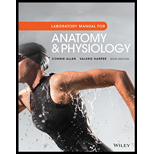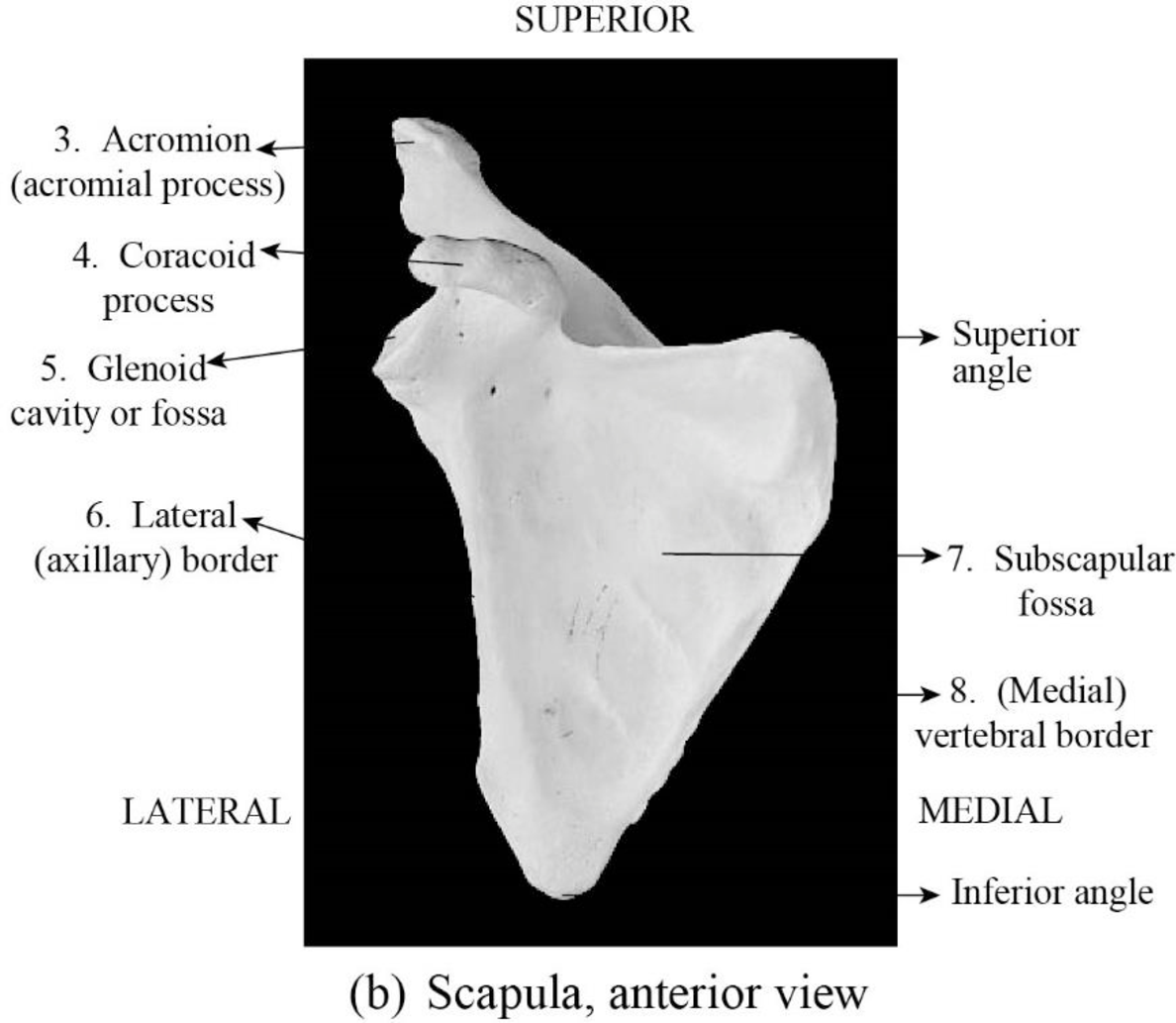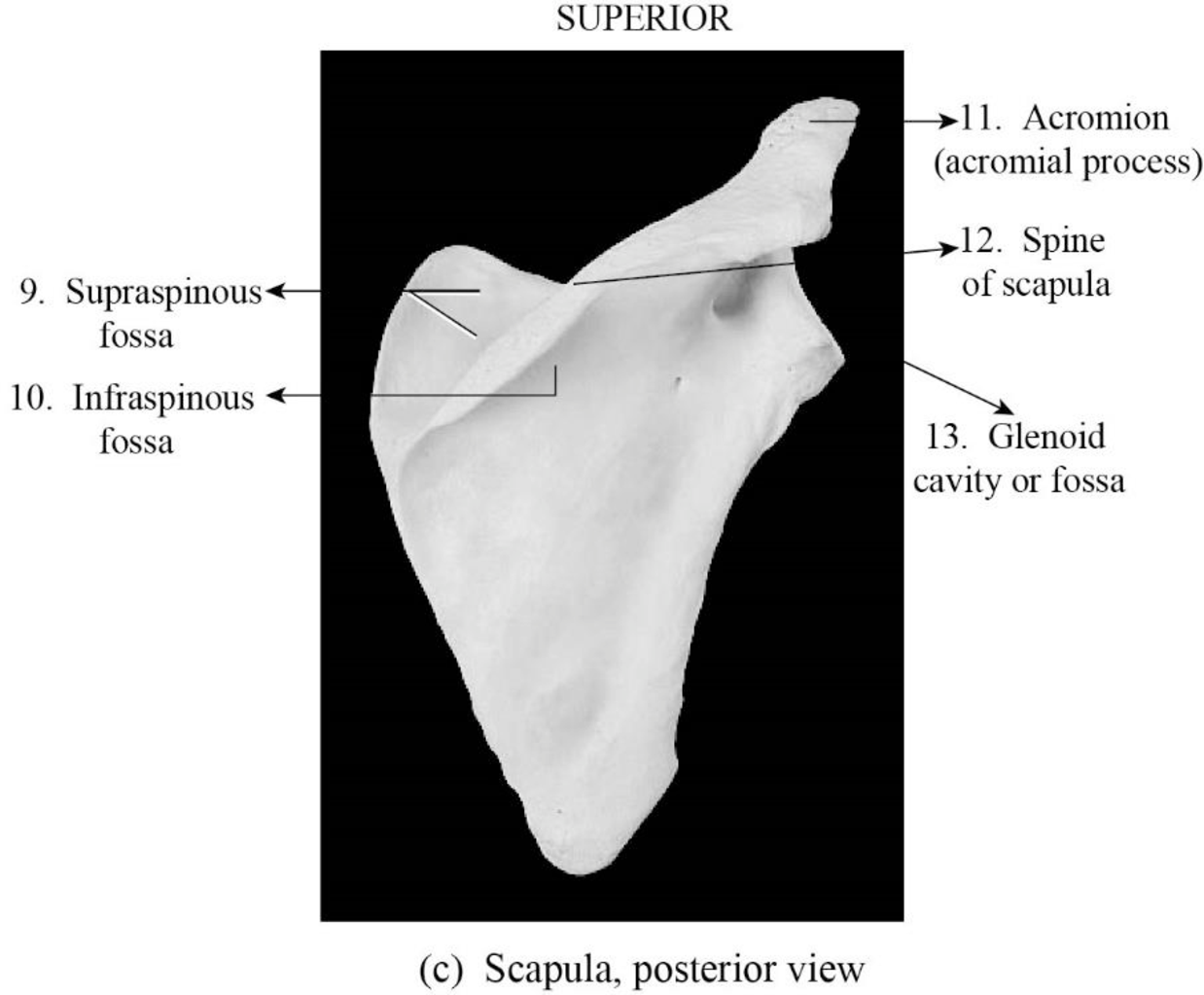
Concept explainers
To label: The parts of the clavicle in Figure 10.2 (a).
Introduction: Pectoral girdles are otherwise called shoulder girdle and they are the set of bones. An upper limb is attached to the axial skeleton by each pectoral girdle. Each shoulder girdle or pectoral girdle is composed of a clavicle and a scapula.
Answer to Problem 1.1BGL
Pictorial representation:

Fig1: The parts of the clavicle
Explanation of Solution
1. Acromial end: The acromial end is the flattened lateral end. It is anchored to the coracoid process by trapezoid ligaments and conoid. It articulates with the acromion.
2. Sternal end: The sternal end is the enlarged medial end. It articulates with manubrium sterni.
To label: The parts of scapula in Figure 10.2 (b).
Answer to Problem 1.1BGL
Pictorial representation:

Fig 2: The parts of the scapula anterior view
Explanation of Solution
3. Acromion (acromial process): Acromion is a portion of the scapula and it is found at the shoulder peak. The shape of the acromion is a triangle and it protrudes laterally. The acromion is otherwise referred as acromion process, which articulates with the collar bone or clavicle to form the acromioclavicular joint.
4. Coracoid process: The coracoid process is a thick, long curved projection attached by a broad base to the upper portion of the neck of the scapula.
5. Glenoid cavity or fossa: Glenoid cavity is a portion of the shoulder. It is depression inferior to acromion. The glenoid cavity is otherwise called a glenoid fossa of the scapula.
6. Lateral (axillary) border: The lateral border is a structural feature on the bone of scapula or border near the axilla. The lateral border of the scapula is also called an axillary border.
7. Subscapular fossa: Subscapular fossa is the concave depression on the anterior surface of the scapula. It provides origin to the subscapularis muscle. The subscapular fossa is otherwise called the shoulder bone.
8. (medial) vertebral border: The vertebral border is the edge or margin of scapula near the vertebral column. It extends to the inferior angle from a superior angle.
To label: The parts of the clavicle in Figure 10.2 (c).
Answer to Problem 1.1BGL
Pictorial representation:

Fig1: The parts of the scapula posterior view
Explanation of Solution
9. Supraspinous fossa: Supraspinous fossa is a depression superior to the spine. It provides origin to the supraspinatus muscle.
10. Infraspinous fossa: Infraspinous fossa is the depression or hollow on the dorsal aspect inferior to the spine. It mainly provides attachment to the infraspinatus muscle.
11. Acromion (acromial process): Acromion is the portion of the scapula and it is found at the shoulder peak. The acromion is otherwise referred as acromion process, which articulates with the collar bone or clavicle to form the acromioclavicular joint.
12. Spine of the scapula: The spine of the scapula is otherwise called a scapular spine. It is a sharp ridge present on the posterior side.
13. Glenoid cavity or fossa: Glenoid cavity is otherwise called a glenoid fossa of the scapula. The glenoid cavity is a portion of the shoulder. It is a depression inferior to acromion.
Want to see more full solutions like this?
Chapter 10 Solutions
EBK LABORATORY MANUAL FOR ANATOMY AND P
- What is behavioral adaptarrow_forward22. Which of the following mutant proteins is expected to have a dominant negative effect when over- expressed in normal cells? a. mutant PI3-kinase that lacks the SH2 domain but retains the kinase function b. mutant Grb2 protein that cannot bind to RTK c. mutant RTK that lacks the extracellular domain d. mutant PDK that has the PH domain but lost the kinase function e. all of the abovearrow_forwardWhat is the label ?arrow_forward
- Can you described the image? Can you explain the question as well their answer and how to get to an answer to an problem like this?arrow_forwardglg 112 mid unit assignment Identifying melting processesarrow_forwardGive only the mode of inheritance consistent with all three pedigrees and only two reasons that support this, nothing more, (it shouldn't take too long)arrow_forward
- Oarrow_forwardDescribe the principle of homeostasis.arrow_forwardExplain how the hormones of the glands listed below travel around the body to target organs and tissues : Pituitary gland Hypothalamus Thyroid Parathyroid Adrenal Pineal Pancreas(islets of langerhans) Gonads (testes and ovaries) Placentaarrow_forward
 Human Anatomy & Physiology (11th Edition)BiologyISBN:9780134580999Author:Elaine N. Marieb, Katja N. HoehnPublisher:PEARSON
Human Anatomy & Physiology (11th Edition)BiologyISBN:9780134580999Author:Elaine N. Marieb, Katja N. HoehnPublisher:PEARSON Biology 2eBiologyISBN:9781947172517Author:Matthew Douglas, Jung Choi, Mary Ann ClarkPublisher:OpenStax
Biology 2eBiologyISBN:9781947172517Author:Matthew Douglas, Jung Choi, Mary Ann ClarkPublisher:OpenStax Anatomy & PhysiologyBiologyISBN:9781259398629Author:McKinley, Michael P., O'loughlin, Valerie Dean, Bidle, Theresa StouterPublisher:Mcgraw Hill Education,
Anatomy & PhysiologyBiologyISBN:9781259398629Author:McKinley, Michael P., O'loughlin, Valerie Dean, Bidle, Theresa StouterPublisher:Mcgraw Hill Education, Molecular Biology of the Cell (Sixth Edition)BiologyISBN:9780815344322Author:Bruce Alberts, Alexander D. Johnson, Julian Lewis, David Morgan, Martin Raff, Keith Roberts, Peter WalterPublisher:W. W. Norton & Company
Molecular Biology of the Cell (Sixth Edition)BiologyISBN:9780815344322Author:Bruce Alberts, Alexander D. Johnson, Julian Lewis, David Morgan, Martin Raff, Keith Roberts, Peter WalterPublisher:W. W. Norton & Company Laboratory Manual For Human Anatomy & PhysiologyBiologyISBN:9781260159363Author:Martin, Terry R., Prentice-craver, CynthiaPublisher:McGraw-Hill Publishing Co.
Laboratory Manual For Human Anatomy & PhysiologyBiologyISBN:9781260159363Author:Martin, Terry R., Prentice-craver, CynthiaPublisher:McGraw-Hill Publishing Co. Inquiry Into Life (16th Edition)BiologyISBN:9781260231700Author:Sylvia S. Mader, Michael WindelspechtPublisher:McGraw Hill Education
Inquiry Into Life (16th Edition)BiologyISBN:9781260231700Author:Sylvia S. Mader, Michael WindelspechtPublisher:McGraw Hill Education





